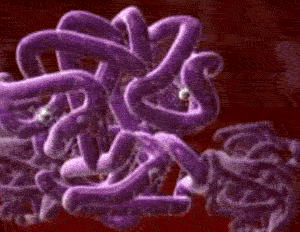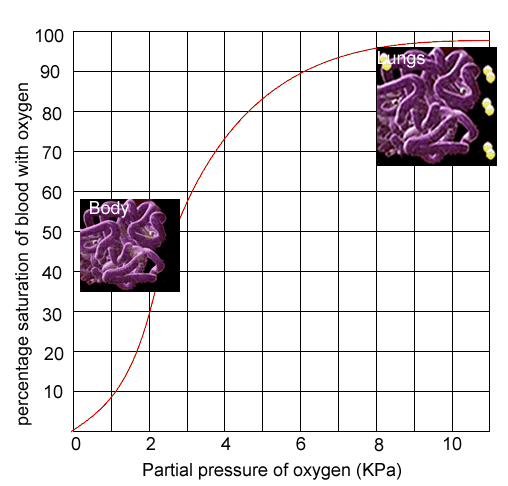Oxygen is not very soluble in water. In fact only 3 mL of oxygen can dissolve in 1 litre of blood plasma. Blood containing red blood cells however can carry 70 times as much oxygen as the equivalent volume of blood plasma.
Haemoglobin is a complex protein molecule that combines with oxygen molecules via four iron atoms within its structure.When 4 oxygen molecules bond to the haemoglobin protein it forms oxyhaemoglobin. The bond between the iron and the oxygen molecule readily forms in the lungs but is not a permanent one and can readily be broken in the tissues where oxygen is needed.

Haemoglobin is very quick to take up oxygen and quickly saturates the blood with this life sustaining gas.
Below is a graph of partial pressure of oxygen vs percentage saturation of the blood. Notice the "S" shaped curve. It indicates that the blood can quickly become saturated at a relatively low pressure of oxygen, say 8 kPa. At this relatively low pressure the blood is more than 90% saturated.

The steep part of the curve represents the pressure of oxygen found in the tissues. At this part of the curve, say between 2 and 6 kPa, a small drop in pressure results in big changes to the percentage saturation of the blood hence driving oxygen out of the blood and into the tissues.
To say it in a different way, if the pressure of oxygen gas falls due to utilisation by the tissues, the haemoglobin responds by releasing more oxygen into the tissue.
This oxygen saturation curve is therefore well suited to taking up oxygen in the lungs and releasing it in the tissues.
Haemoglobin increases the speed with which oxygen enters red blood cells and
Without haemoglobin
Explain why a diet lacking iron would cause someone to feel tired and lethargic?